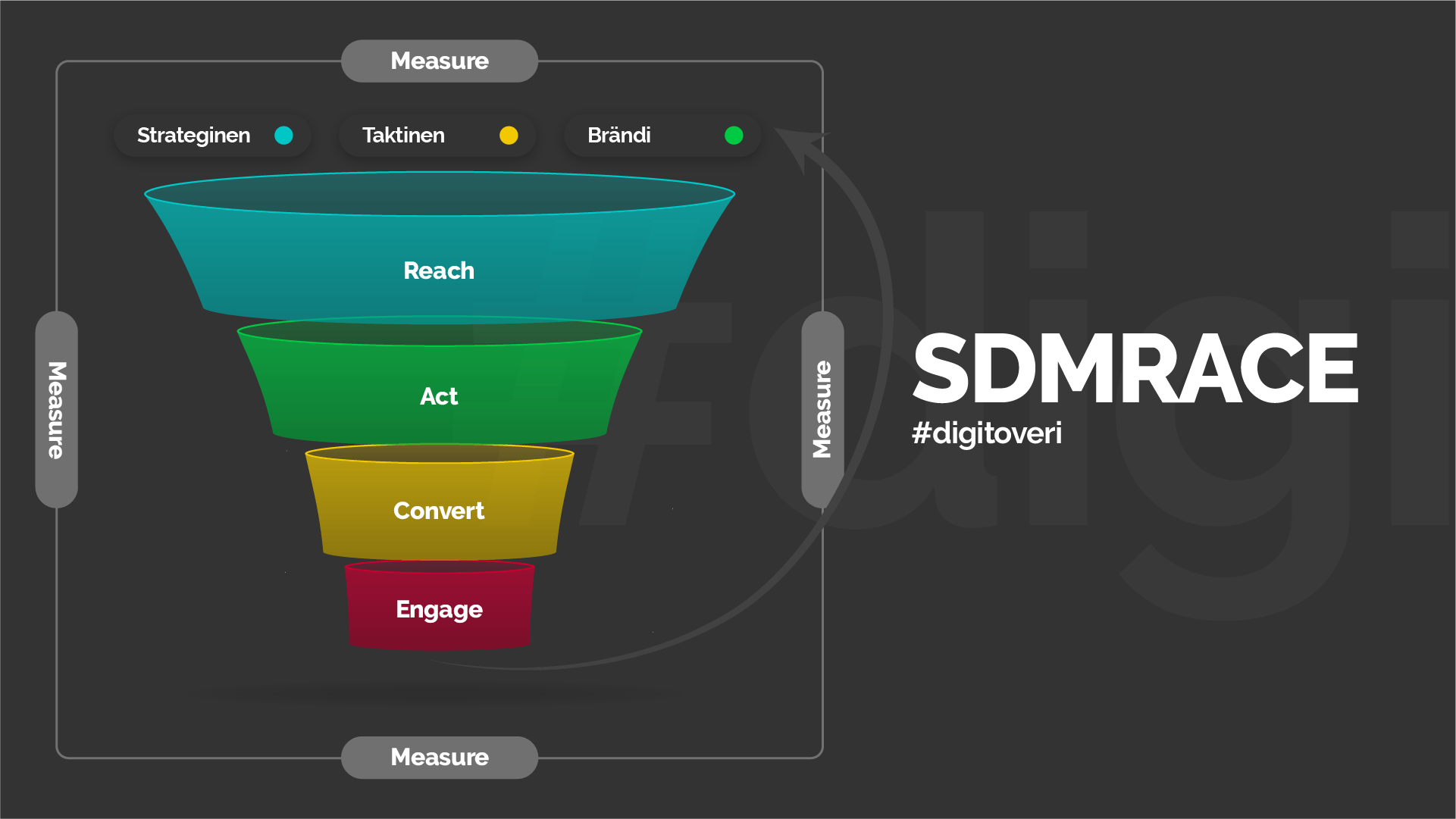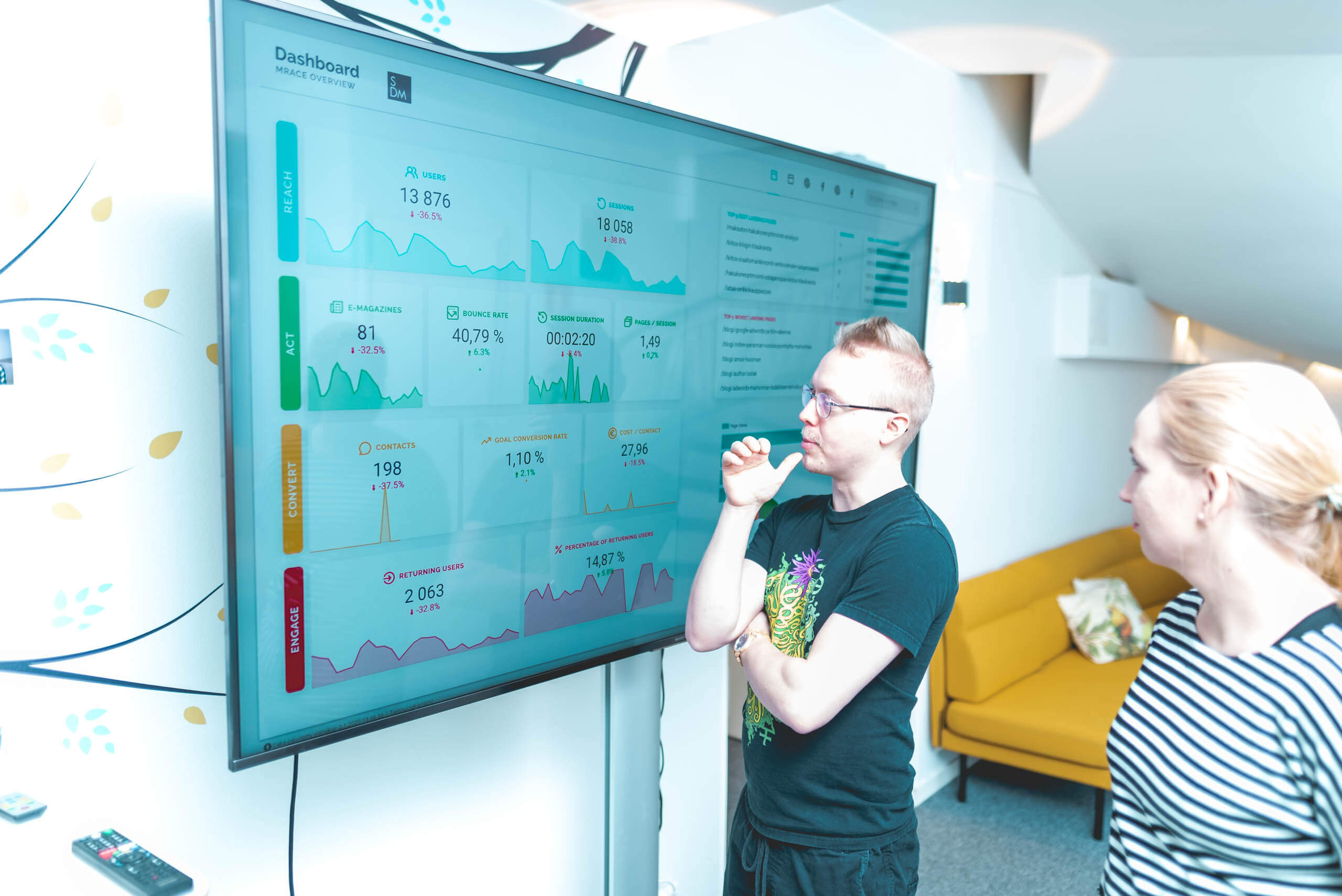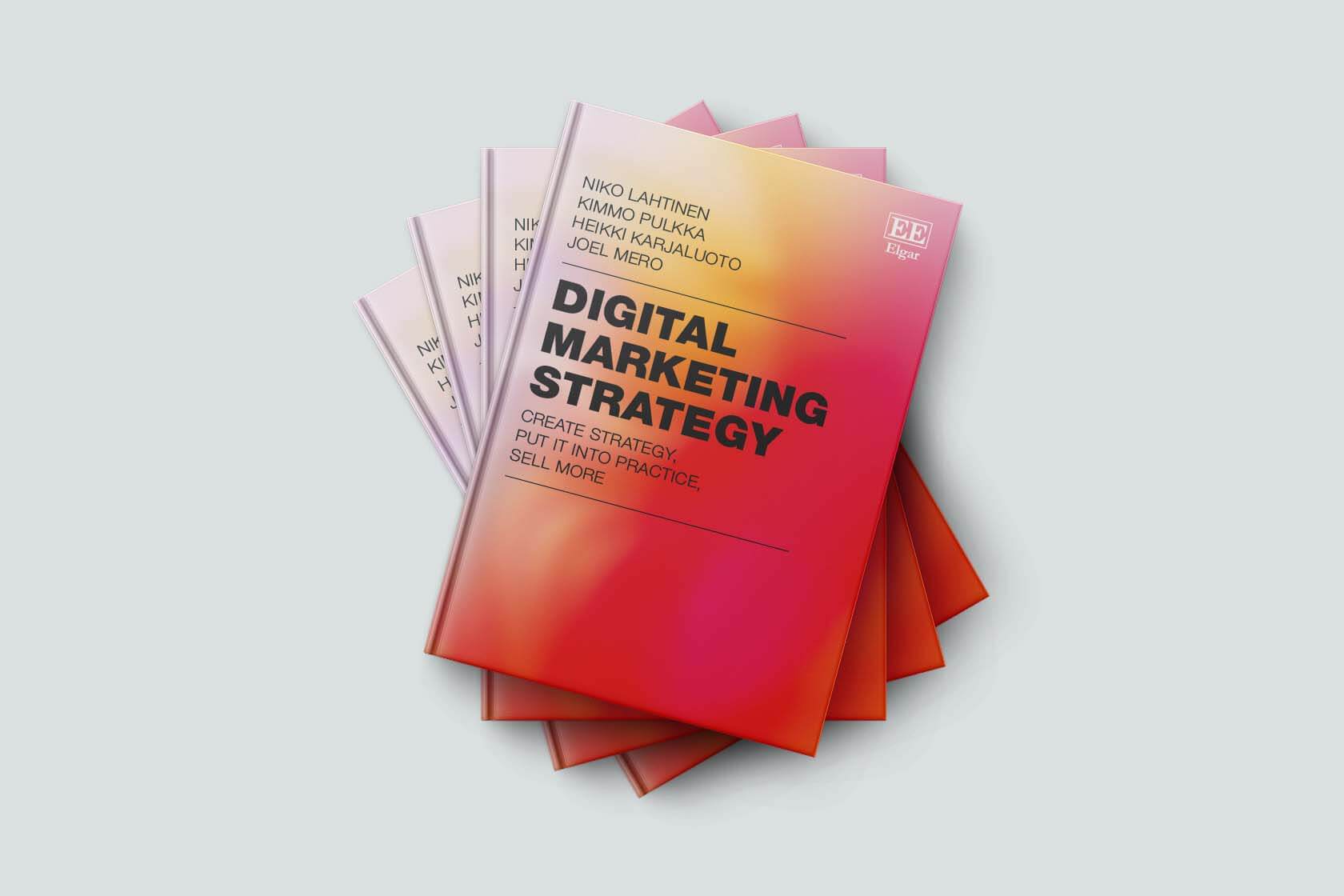Built with multiple channels, the sales funnel produces ready-to-sell leads or direct trade. The most important thing about building a sales funnel is that all channels play together.
The sales funnel can be divided into four different stages:
- Reach, you reach a potential customer and capture their interest
- Act, you can get the customer to perform recognizable actions on your site, such as reading blogs and references, and visiting service pages
- Convert, the customer makes the desired conversion, turning them into either a lead or a customer
- Engage, you engage the customer in your company because profitable growth comes from long-term customer relationships
The first letters of these words make up the RACE model. When you add more measurement to the model, the MRACE model that we use is created. MRACE is not really just a model built to describe a sales funnel, but it can (and should) be used to build the marketing of the entire company. In this case, your company’s marketing plays a game together, and the actual sales funnels are not even needed, because your marketing already works like a sales funnel.
Reach, Act, Convert and Engage operate in marketing with exactly the same mathematics as normal sales. The more relevant appointments (Reach), the more you can solve customer issues and help them (Act). The more you help your customers, the more they create a transaction (Convert). The better you take care of your customers after you make a sale, the better you can make further sales (Engage).
The principle is therefore very simple. In this blog, I focus on how you can build a sales funnel that depending on your business, generates either ready-to-sell leads or direct sales.
The MRACE framework is a model built to manage the marketing entity, but it can also be used to build sales funnels.
A sales funnel is often described as a straightforward process in which a customer simply drops into the funnel and slides with a smile at the mouth of the money-paying customer. However, this is not the case, and the visitors who convert can be roughly divided into two groups: the minority who convert immediately and the majority who convert on average 5-6 visits to your site.
Because of this latter majority, all marketing channels must play a role together.
How to build a sales funnel?
In this blog, I go through the construction of a comprehensive sales funnel suitable for B2B and the sale of valuable B2C products and services (e.g. renovations). Many B2B solutions and valuable B2C products require a lot of information retrieval and discussion before a purchase decision is made. As a result, the sales funnel also requires more content and different channels.
Without the right kind of content, the funnel will not work
I wrote earlier. why content marketing is the most important element of digital marketing. That is what it is in the sales funnel. While we can search Facebook and Google for the most ready-to-buy audiences and target advertising to them, no one will buy your product if you do not sell it to them with your content.
Your product or service is certainly the answer to the customer’s problems, but if you do not answer the customer’s questions with your content, there will be no connection between your product and your customer’s needs.
“Your product is the answer, but what is the customer’s question?”
Therefore, before you start driving traffic to your site, your site needs to be both content and technically fit. With the help of content, you need to build purchase paths on the site, which we call lead mills. When we build the content correctly, they lead the customer from the top of the funnel to ready-to-sell leads. It is also important to take into account conversion optimization in the functionality of the sales funnel, so that the customer’s travel in the funnel is as smooth as possible.
Let’s start building a funnel.
1) Reach – make yourself discoverable and awaken the interest of your audience
Reach is right at the top of the sales funnel. The goal is to reach target groups according to your buyer. At this point, we can roughly divide our customers within each buyer persona into three different segments:
1) People actively looking for your product
2) People looking for a product like your product
3) People who are not looking for your product
I deliberately excluded the people looking for the product of your company directly, because then the sales funnel role is not as big. If you imagine selling oat milk, then the people in segment 1 say, “I’m looking for oat milk.” The people in segment 2 say, “I’m looking for milk.” The customers in segment 3 say nothing.
To reach these segments, you will need a few different digital marketing channels, the most important of which are Facebook/Instagram (in some cases LinkedIn), Google Ads, and a href=”/hakukoneoptimointi-seo” target=”_blank” rel=”noopener noreferrer”>search engine optimization.
Next, I will go over which channels you can use to get as much of the relevant customer flow as possible from these three segments to move to your website.
People who are actively looking for your product
There are two ways to find people looking for your product on your site: Google Ads or organic search results, thanks to search engine optimization.
You can read about the role of Google Ads here.
People looking for a product like your product
Such individuals are not looking for your product but are looking for another product that solves the same problem as your product. In this case, we are able to target people who have visited/searched your competitors’ websites.
People who are not looking for your product
For these people, it is most successful to advertise through Google Display and social media channels (Facebook is usually the best). In raising awareness, Youtube is a good option.
Facebook lets you communicate with your audience about the challenges or needs they have experienced. When the audience recognizes itself from the message “I have that problem,” you can start by using the right content to create a link between the product you offer and the solution to your customer’s problem. This way, the need for the target group begins to channel towards your product.
2) Act – convince site visitors with your expertise and turn them into leads with good content
Act is the most crucial step in the entire sales funnel. It determines whether a site visitor turns into a leads/opportunity and therefore, a customer.
At Reach, you captured their interest and made yourself discoverable. It is an easy job compared to the Act phase. In this phase, you need to get a site visitor to spend their precious time on your site and consume content so much that they contact you or download a guide, for example, and thus leave you their contact information.
The goal in the Act phase is to get the buyers to walk along the purchase path according to the driver controlling their purchase decision towards the desired function (e.g. downloading the guide). The more strategically a lead grinder created by your content is built on your site, the better it will absorb visitors deeper into your site.
An example of drivers: when buying marketing, one person wants to develop a brand and the other wants sales leads. The purchasing paths of these two buyers should be distinguished and the content of each purchasing path should focus entirely on the factor that most guides the purchasing decision of the buyer personalities, i.e. the driver.
What makes the Act phase challenging is that you need to be more interesting than the rest of your life at that moment
In the Act phase, the interplay across channels must work seamlessly because customer purchase processes are not straightforward (interest-information-finding comparison purchase). It is entirely due to two things: 1) it is normal to consider a purchase decision several times and for a long time, 2) things are constantly happening in life that will absorb your customers’ attention elsewhere.
A hard-built lead mill and a complete blog post does not weigh much on your customer’s meter when a child starts crying, when a friend calls, or when a spouse asks for help with cooking. Or simply watching Netflix can feel more comfortable at that exact moment, even if you are in the middle of reading a blog.
Whatever the reason, the buying process stops.
Therefore, you need to get a customer to your site to continue their buying process through remarketing. Remarketing to such warm audiences is very affordable and productive when done right. At its best, you can advertise to the customer the blog where their purchase process was interrupted.
Social media in the Act phase
In addition to remarketing, social media plays another strong role in the Act phase. It allows you to take Act-stage content to people who are already interested in your product and direct them to your site. The purchase process for this group may have been unfinished a long time ago, but with a properly formatted message, you can keep it going.
In addition to this, your message will also reach numerous other people. Based on micro conversions like watching a video or going to the site, you can identify completely new customer segments that are interested in your services. Facebook’s AI recognizes if specific types of people respond to your advertising, go to your pages, and become leads. Now you can create a targeting for Facebook that will help it start finding more similar people on Facebook and showing them advertising.
What content do you need for your website in the Act phase?
The content at the top end of the sales funnel plays a crucial role in how well the sales funnel starts to work. If you are talking about your product, you are only addressing the audience that already wants your product. That mass is usually quite small.
The content at the top of the sales funnel should focus purely on the reader. Content should address the problems, needs, goals, and daily challenges of your buyer personality. The more accurately you can describe the problems and desires of your buyer personality, the more likely they are that you have a solution to them.
At the top of the sales funnel, customers search a lot with need, problem, and motivation-based keywords. “How do I generate leads”, “The car make a strange noise when it starts”, etc. If the content only processes your product, then you will not be found in the search results with such keywords.
It is important to do keyword research because it also serves as the backbone of the content. When the content focuses on the keywords your customers are searching for, SEO starts to bring far-reaching results.
The content of the Act phase should also create clear driver-based purchasing paths to support customer information retrieval.
Let me give you an example. The person googles “How to improve the clustering percentage of sellers”. They end up with “How to improve the clustering percentage of sellers through marketing”. Now we start teaching them how a poor cloning percentage is not necessarily due to vendors, but to the poor quality of leads. The person is interested and continues to read.
After the interest is captured, we start leading the person to other content: “Generation of high-quality leads for B2B companies”, “Generating leads from Facebook to B2B companies”, “Download the toolbox of a modern sales director: 37 tools to streamline your sales process and improve the quality of your trigger”.
This allowed us to reach an unknown person with a generic “How to improve your sellers’ clustering rate through marketing” blog post and to redirect them to blog posts based on their interests. Finally, they downloaded the guide, and we start warming them up as a lead with marketing automation or direct contact.
Note that this was an example of just one downscale buying path for one buyer persona.
3) Convert – turn leads into a store
The Convert step includes the time when the customer is a lead, but not yet a paying customer. The nature and length of this stage varies greatly per product. In some products, the reflection period is long, while in some the purchase decision is made quickly. In some products, the biggest responsibility lies with the seller, while in others the responsibility lies with marketing. For example, it is difficult to buy marketing services without a seller, while in many SaaS services it is possible to buy without a single contact with the seller.
Remarketing keeps your business in the mind of the lead
In the Convert phase, one of the most effective ways in which marketing can support sales is to reference stories for advertising ideas through remarketing. This way, your business stays in the mind of the lead, but at the same time convinces them of your competence. If they have sent multiple invitations to tender to different companies, then relatable reference stories can play a significant role in getting the deal clustered for you.
Marketing Automation notifies you when sales need to contact the customer
Without exception, every marketing automation tool provides a feature that allows you to see what each visitor has done on your website. The feature does not exist so that marketers can stalk late at night which blog someone has been reading. Its purpose is, among other things, to communicate with sellers when to contact the visit in question.
Let’s say that two different visitors download the guide on your website, and they join the marketing automation circuit. One of the individuals fills out the form but does not even open the guide during the first week. The other one opens it immediately and visits your service page and various reference pages on the same day. Marketing automation allows your seller to receive automatic notification of the latter person’s activity to their email, allowing them to spend their time on a clearly most ready-to-buy lead.
The importance of such automations is especially pronounced when there are many leads.
What content do you need on your website for the Convert phase?
At this point, the lead is clearly interested in your product. That is why the most important thing is that you teach them how to make the right choice. Reference stories, case studies, buyer’s guides, interactive product selectors, comparisons, and expert content help.
The contents of the Convert phase must create relatability and remove barriers to purchase. In addition, they must be built in such a way that the leads feel that they no longer want to be in their current state but want the future that your product will bring. Often, we are too comfortable, which means that the “good” current state is perceived as a better option than painful information retrieval and a long buying process, even if it is better then. Therefore, content should also communicate strongly what happens if the lead does not change its current state.
4) Engage – Engage customers into your business to grow your business
The bucket will not stay full if it has holes. The business will not grow either if there is a large customer outing. Therefore, customer engagement should be given the same attention as the acquisition of new customers.
In the Engage phase, marketing aims to ensure that the customer commits to your company. Depending on the business, that means very different things. For example, in SaaS companies, the Engage phase starts as soon as the free trial starts, because the customer needs to be taught a lot through content marketing. This way, they learn how to use the tool and does not switch back to the old one or stop studying.
A company that is doing renovations should send a segmented newsletter to those who have carried out kitchen renovations, for example, about kitchen decor. Gradually, the angle of entry can also be turned to decorate the rest of the home, which will capture the customer’s interest in the next renovation.
Simply put, the Engage phase marketing teaches your customer to use the product they are buying more often and better. This is done through remarketing on social media and Google, as well as email marketing. However, the focus of everything is search engine-optimized content, to which you direct your customer through the channels mentioned above. If the search engine optimization is in order, visitors will flow steadily from day to day, even if no more euros are put into marketing.
What content do you need on your website for the Engage phase?
I mentioned earlier that engage stage content teaches your customer how to use your product better and more often. Software is used more when you teach your customers how to use it in the most versatile way possible. The frying pan is used more when writing recipes for your customers. The idea is therefore very simple, but the contents of this stage often want to stay on the feet of new customer acquisition.
However, the contents of the Engage phase are also useful in acquiring new customers. If a lead reads about customer engagement content, what you can do with your product, and sees how easy it is, then of course he or she will be more likely to buy the product.
5) Measure – When marketing is measured, it can also be developed
In digital channels, everything can be measured, which is a great opportunity in terms of marketing development. At the same time, however, it is also one of the greatest risks. Data volume easily drowns, and wrong numbers can distract . In addition, often the quality of the data is poor, in which case its interpretation can even lead to wrong conclusions.
If you want to delve deeper into measuring, read here about the Marketing Dashboard, to track sales funnel figures in real time and in visual form.
Summary
The MRACE model is the marketing framework by which digital marketing channels work together rather than in their own silos. As a result, your marketing will appear consistent and consistent to your customers, increasing both the results of the marketing and the brand impact.
In summary:
- Conversion-optimized websites are the bottom line
- Websites are filled with buyer-specific content that makes up lead mills, or purchase paths
- Lead mills drive traffic through a variety of channels, and a properly built lead mill collects organic traffic from search engines, so marketing always stays on
- When a customer’s Purchase Process is interrupted, they will be reinstated by remarketing to where they left off
- Everything is structured to direct the customer to the desired action, such as submitting a request for quotation, contacting us, or downloading a buyer’s guide
Shall we look at how your digital channels are currently playing together? Contact us!










